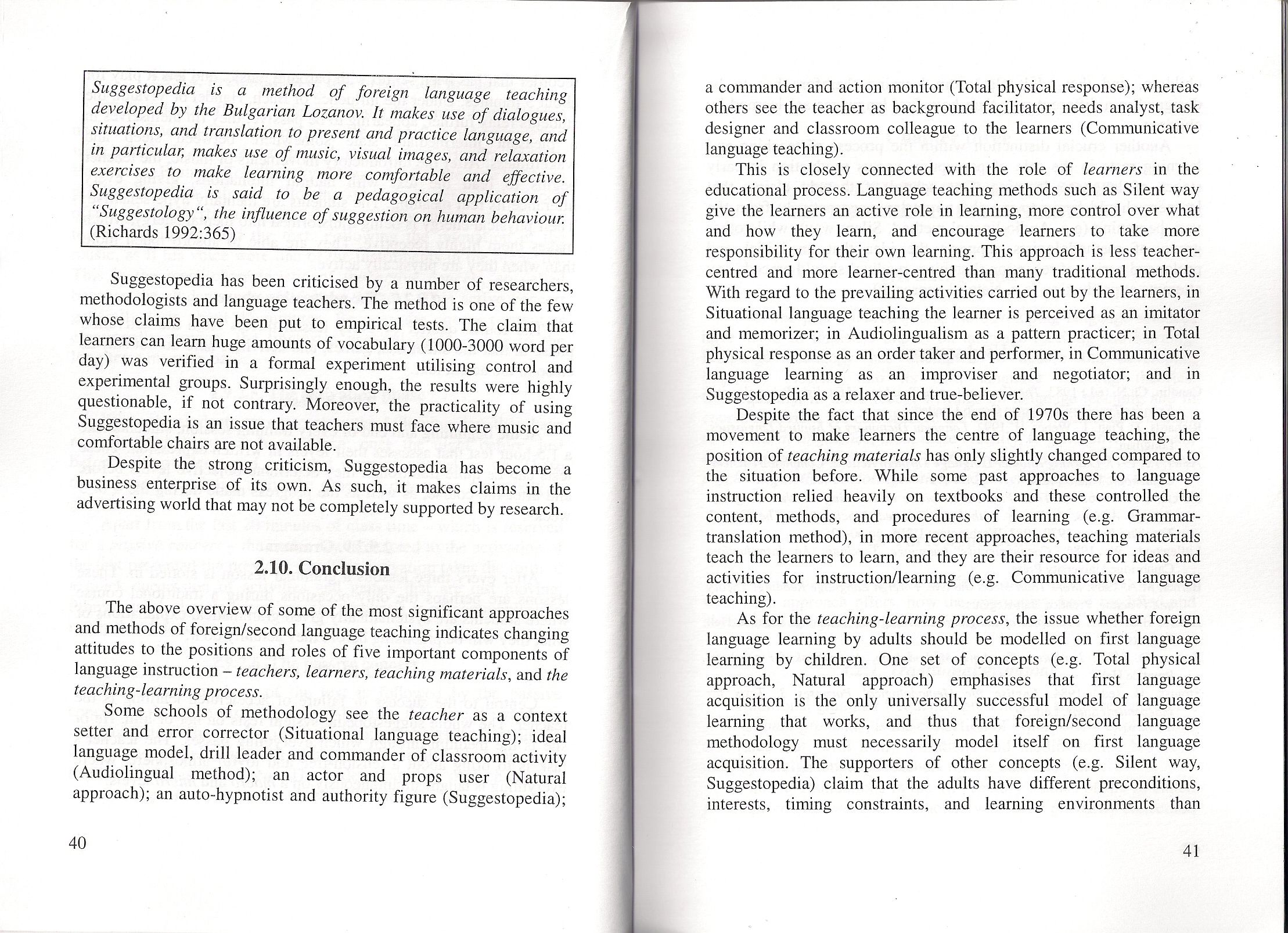skanowanie0020 (27)

Suggestopedia is a method of foreign language teaching developed by the Bulgarian Lozanov. It makes use of dialogues, situations, and translation to present and practice language, and in particular, makes use of musie, visual images, and relaxation exercises to make leaming morę comfortable and ęffective. Suggestopedia is said to be a pedagogical application of “Suggestology“, the influence of suggestion on human behaviour. (Richards 1992:365)
Suggestopedia has been criticised by a number of researchers, methodologists and language teachers. The method is one of the few whose claims have been put to empirical tests. The claim that leamers can leam huge amounts of vocabulary (1000-3000 word per day) was verified in a formal experiment utilising control and experimental groups. Surprisingly enough, the results were highly ąuestionable, if not contrary. Moreover, the practicality of using Suggestopedia is an issue that teachers must face where musie and comfortable chairs are not available.
Despite the strong criticism, Suggestopedia has become a business enterprise of its own. As such, it makes claims in the advertising world that may not be completely supported by research.
2.10. Conclusion
The above overview of some of the most significant approaches and methods of foreign/second language teaching indicates changing attitudes to the positions and roles of five important components of language instruction - teachers, leamers, teaching materials, and the teaching-learning process.
Some schools of methodology see the teacher as a context setter and error corrector (Situational language teaching); ideał language model, drill leader and commander of classroom activity (Audiolingual method); an actor and props user (Natural approach); an auto-hypnotist and authority figurę (Suggestopedia);
a commander and action monitor (Total physical response); whereas others see the teacher as background facilitator, needs analyst, task designer and classroom colleague to the leamers (Communicative language teaching).
This is closely connected with the role of leamers in the educational process. Language teaching methods such as Silent way give the leamers an active role in leaming, morę control over what and how they learn, and encourage leamers to take morę responsibility for their own learning. This approach is less teacher-centred and morę leamer-centred than many traditional methods. With regard to the prevailing activities carried out by the leamers, in Situational language teaching the leamer is perceived as an imitator and memorizer; in Audiolingualism as a pattem practicer; in Total physical response as an order taker and performer, in Communicative language leaming as an improviser and negotiator; and in Suggestopedia as a relaxer and true-believer.
Despite the fact that sińce the end of 1970s there has been a movement to make leamers the centre of language teaching, the position of teaching materials has only slightly changed compared to the situation before. While some past approaches to language instruction relied heavily on textbooks and these controlled the content, methods, and procedures of learning (e.g. Grammar-translation method), in morę recent approaches, teaching materials teach the learners to leam, and they are their resource for ideas and activities for instruction/leaming (e.g. Communicative language teaching).
As for the teaching-leaming process, the issue whether foreign language learning by adults should be modelled on first language learning by children. One set of concepts (e.g. Total physical approach, Natural approach) emphasises that first language acąuisition is the only universally successful model of language leaming that works, and thus that foreign/śecond language methodology must necessarily model itself on first language acąuisition. The supporters of other concepts (e.g. Silent way, Suggestopedia) claim that the adults have different preconditions, interests, timing constraints, and learning environments than
41
Wyszukiwarka
Podobne podstrony:
Snggpstopedia Suggestopedia is a method of foreign language teaching developed by Bulgarian doctor a
The siknt Way The sileni way is a metliod of foreign language teacliing developed by Caleb Gattegno
The Pirect Method The direct metliod is a method of foreign or second language teaching which has th
skanowanie0005 (107) PART ONE Chapter one AIMS AND OBJECTIVES OF FOREIGN LANGUAGE TEACHING 1.0. Term
skanowanie0109 r Grauberg, W. 1997. The Elements of Foreign Language Teaching. Multilingual Matters
The Gramniar-Translation Method (Classical Method) The grammar-translation method is a method of for
The Natural Ąpproach The natural approacli is a metliod of second language teaching proposed by S. K
(iv) (v) Q.P. Codę: 13897 is a method of introducing new products with thc same brand namc. (a)
fWORPHOLOGY (is a method of creating r>ew lexemes from the already exisłing ones) delive delivere
Plan Mousillon Duchy MapCity of the Damned Tht north gatt oj the city is Nocked by the Charnel Hills
skanowanie0011 (59) 2.3.3 The main characteristics ofthe OralApproach 1. Language
więcej podobnych podstron